Abstract An attempt to account for the apparent support that G.W. Bush still enjoys among Americans in late 2002, addressing the vengeful role being played by the President, and arguing that familiar vigilante action film narratives are the operative model for his brand of post-9/11 adventure politics. |

State Vigilantism:American Adventure Politicsby Andy Deck |
The Bush Administration has inspired countless articles critical of its handling of everything from environmental policy to the "war on terror." Like a lot of people, I have dissected the specific failings of the Administration's policies. But in spite of an abundance of criticism, most Americans still, apparently,1 endorse Bush's performance. Few presidents have presided over comparably dismal economic times with high approval ratings. In an effort to understand this support, perhaps it will help to analyze the ways that world events and politics relate to the make-believe realm of American media.
Many argue that Americans are being manipulated by their news media, which delivers, above all, entertainment rather than critical and investigative journalism. Often it is true that the news of the day is announced by the president's press secretary, and questioned only slightly by the press, which is inclined to accept the Administration's premises. When an opposing view is offered, frequently it appears in the third or fourth paragraph of an article -- long after the headline has delivered the message intended by Whitehouse strategists. Then, too, there has been a tendency toward media consolidation for decades in the U.S. which has led to a diminished range of viewpoints in print, radio, and television. Right-wing talk radio is beamed from coast to coast, television news parades an endless series of hawks and conservatives as experts, and daily newspapers rarely offer anything that could be construed as pacifist or left-of-center editorial opinion.
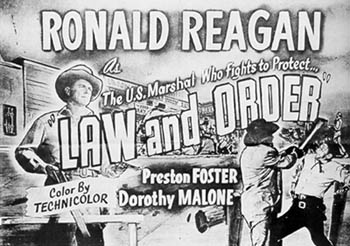 |
 |
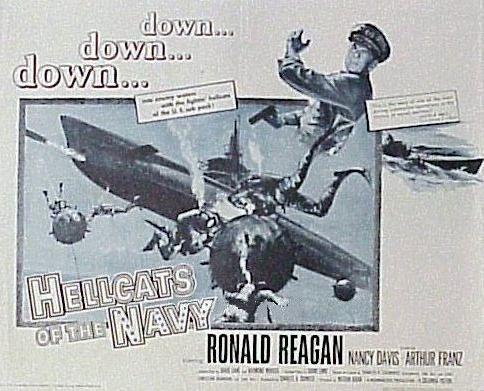 |
|
While the manipulation thesis has explanatory value, it tends to focus on journalism and information,-- relatively dispassionate and argumentative channels of persuasion. Yet the formation of opinion about subjects like war and terror can have as much to do with emotion as with rhetoric. When politics are aestheticized, public approval may be more of a response to aesthetics than to facts. Noting the frustrating lack of traction that factual argumentation has delivered, Bush's critics may do well to consider that the present climate of approval is inspired by some of America's favorite fantasies.
Ronald Reagan's easy transition from actor to president confirmed that for Americans not much separates movie fiction from political drama. The same heroic formula appears to operate in both spheres. Reagan played rugged heros and saved Americans from danger in his movies. He embodied the law. As president Reagan wore a cowboy hat and declared the Soviet Union to be the Evil Empire. He was an accessory to the Iran-Contra scandal, but he played dumb and got away with it. Publicly he played the hero, and Americans tended to believe in him.
In the sequel Bush, Jr., tries to recreate the political theater of the Reagan years, with minor variations. After the controversial election, the Bush camp began experimenting with the president's public persona. Bush donned a leather flight jacket in an early visit to Camp David. Likewise, his rustic vacations in Texas, where he chops wood, appear to be intended to call to mind Reagan's horse back riding.
Although his acting is worse than Reagan's, Bush attempts to adopt many of the same roles -- appearing alternately as fearless leader, wise father, hard-nosed diplomat, CEO, and cowboy. He talks tough about "evil doers" and the "axis of evil." Like Reagan, it has become clear in Bush's first years in office that he is not really the architect of his Administration's policies. Rather, he provides the public face for a drama scripted mostly by the supporting cast. It remains to be seen whether the remake will continue to deflect criticism as well as the Teflon President.
"Just three days removed from these events, Americans do not yet have the distance of history. But our responsibility to history is already clear: to answer these attacks and rid the world of evil. War has been waged against us by stealth and deceit and murder. This nation is peaceful, but fierce when stirred to anger. The conflict was begun on the timing and terms of others. It will end in a way, and at an hour, of our choosing" (G. W. Bush, Sept. 14, 2001).
During the first years of his presidency, Bush was assailed for his policies, and some of the criticism seemed to be sticking. However, in the wake of September 11th, the Bush Administration lurched into a new mode, adopting a politics of vigilantism. With pensions dwindling and corporate scandals flaring up all over, sustaining support for Bush demanded that attention be directed towards external threats, especially the so called "war on terror." Keeping the public focused on war, advised Republican strategist Karl Rove in a leaked strategy document, would "maintain a positive issue environment."2 Out of the raw material of indignation, patriotism, revenge, fear, and uncertainty, the Bush Administration started to patch together an epic of adventure politics.
  |
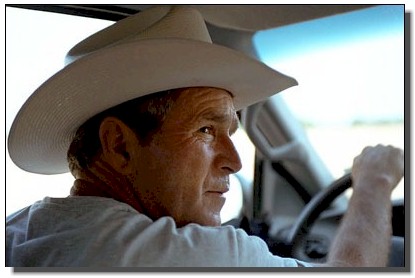 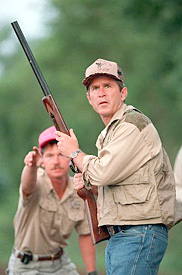 |
  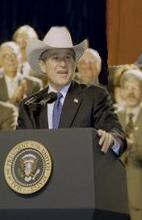 |
Following the September attacks, members of the Administration began asserting that the terrorists were "extremely sophisticated."3 Bush officials claimed there were "thousands" if not "tens of thousands"4 of terrorists operating in "terror cells" in Afghanistan and elsewhere. It soon became a consistent plank of the Bush doctrine that, although 9/11 had been bad, greater dangers lay ahead. Such dire predictions offered foreshadowing of the strife that would follow.5 Americans were led to expect years of war. Inspired by films like Collateral Damage and The Peacemaker, Bush tapped into heroic dreams of defeating terrorism, en route to a vague global Pax Americana. Though his bellicose and inflexible execution of foreign policy belongs in a movie, it has actually brought movie mythology into the realm of daily life.
The Bush Administration contends that its foreign military action will lead to domestic American safety. Defending this position, the Administration often claims that secret information motivates its policies. Such a politics of secrecy gives full flight to public paranoia and fear, while requiring minimal proof. A shortage of facts, combined with fearfulness, lends a special importance to the imagination. Portraying its use of force and intimidation as a means to protect the public from harm, the Administration has found a rationale for its actions that is doubly potent because Americans see this violent formula enacted successfully in myriad movies and television programs. Although there are few documentaries on broadcast television,6 and a lack of substantive political journalism in general, there is no shortage of simplistic dramas featuring gun-toting alpha males who save the weak from danger. These protector figures come in many guises, but thanks to Hollywood narrative conventions and the star system, they rarely fail to set things right.
Attempts by the Bush Administration to attain the form and feeling of Hollywood-style heroism have not been without obstacles. In the movie theater, the action hero is almost always outnumbered and out-gunned. James Bond (Timothy Dalton), for example, fought with the underdog Mujahideen in Afghanistan against a powerful and corrupt Soviet army in The Living Daylights (1987). Similarly, Stallone's Rambo III (1988) was dedicated in the closing frame to the "gallant people of Afghanistan." Notwithstanding frequent assurances that today's terrorists are extremely sophisticated and numerous, the Bush Administration has been unable to conform to this aspect of the adventure narrative: the U.S. has played an unconvincing underdog. Operation Infinite Justice pitted America's overwhelming force against ragtag groups of men, most of whom were not even members of Al Qaeda.7 Many of the Afghan soldiers were conscripted, thrust into the position of having to defend their country.
Though the Taliban leadership had signaled a willingness to discuss the extradition of Osama Bin Laden,8 the Bush leadership was not interested in talking. Vigilantes prefer to punish rather than negotiate. This pattern of belligerence continued when Saddam Hussein agreed to allow weapons inspectors back into Iraq in September of 2002. The Bush team worked feverishly to convince the American people that goals had changed, that weapons inspections would no longer suffice. Faced with international criticism of its campaign to "rid the world of evil," the Bush Administration pressed on with its moralistic unilateralism, defiant of the United Nations and international opinion in general.
Hollywood action heros are often adversaries of the law. They must break the law to achieve a greater good. They are above the law. Clint Eastwood's performances as Dirty Harry exemplify the formula, wherein individual integrity, toughness, and violence save the day. Bush's imitation of this popular vigilante type even includes the signature taunt: instead of "go ahead, make my day" he says "you're either with us or you're with the terrorists." In Bush's Washington, as in Hollywood, laws are often viewed with contempt. In anticipation of what U.S. government officials have called an "inevitable" war with Iraq, international law and U.N. resolutions have been treated as non-binding instruments of the weak which must be overcome by American heroism. Following this narrative logic, the formidable American armed forces serve as a proxy for the hero's pistol. It hardly matters that many people have spoken against Bush's plan -- or even that the enemies have capitulated to his demands. The formula demands that he lay waste to everyone who stands in the way of his supreme justice. He will demonstrate that he is tougher than the rest. And in the end, so the story goes, he will prevail while enemies fall in a hail of bullets.
Life is cheap in B movies. They often maximize deaths-per-minute as a form of entertainment. Bad guys are strewn all about with no attempt made to humanize their deaths. This is also the condition that prevails in "shooter" video games, in which a high score depends on one's ability to kill quickly and without question. Both the video games and the action movies deemphasize dialogue, character development, and psychological realism in favor of pyrotechnic effects. Perhaps Bush's mode of governance complements this popular, hyperviolent entertainment. His simplistic, dualistic vision of "America, her friends, and allies" ridding the world of the "axis of evil" encourages spectators to accept horrific violence without great concern.
Yet to anyone who sees Afghan citizens and Iraqi citizens as fully human, the headlong rush to use the enormous force of advanced technological weaponry must be viewed with alarm. Blindness to the equality of all human life is not a new phenomenon in America, despite the "all men are created equal" ideal expressed in the Declaration of Independence. For years black men counted three-fifths and native Americans not at all. In the modern war spectacle, as in the cinematic spectacle of death, a convincing enemy is a formulaic necessity; and frequently the dehumanization of the enemy has racial overtones. Although Bush has denied that race and religion are motivating factors in his prosecution of the "war on terrorism," the largely passive reception of his wars against the "evil ones" may owe, in part, to prejudices. Physician Michael LeNoir coined the term "image distortion disorder" to describe a representational bias that blurs and obscures our common humanity. "Most of the images that one ethnic group has of another are developed by the media," LeNoir points out. With some minorities often depicted in a bad light, especially on television, media-fed perceptions create "a background of anxiety and fear in America that is dangerous."9
This distortion effect is made particularly dangerous for non-Americans by the awesome force of the U.S. military and the ideology of innocence that surrounds its use. Even in the best of times it seems that, according to the American moral compass, the side of the U.S. military is a priori the side of good in every conflict. But the brutal attacks of 9/11 established an extraordinarily convincing revenge motive. Recognizing the impunity that this raw emotion would afford, the Bush Administration seized the moment to draw hard-line fantasies into the realm of possibility. A wave of nationalism pushed criticism of Bush's jingoist politics to the margins. In the midst of super-charged indignation, censorship became an act of patriotism. Journalists, after all, deserve credit in the co-production of Bush's war epic.
As early as December, 2001, an American researcher concluded that aerial bombing had already killed almost as many Afghan civilians as had died in the September 11th attacks. Nevertheless, as if bound to heroic preconceptions, mainstream journalists and senior editors kept this "collateral damage" off of the front pages. When they did begin to present casualty reports, they favored studies that claimed far fewer civilians had perished. The media watchdog organization FAIR (Freedom and Accuracy in Reporting) has faulted many of those conservative accounts, judging them to be deliberately misleading.10
Although the American media coverage did not capitulate entirely to the Pentagon's perspective, much of the war action occurred off stage, behind a curtain of Pentagon deniability. The flow of information out of Afghanistan was controlled to a greater extent than had been possible in Yugoslavia, where Internet connectivity remained active throughout the American-led bombing campaign in 1999. This left much to the imagination. From the start, the bombing campaign was shadowed by the specter of civilian carnage. But with few witnesses in the field, news reports relied heavily on Pentagon briefings. During the first week Defense Secretary Donald Rumsfeld fielded questions, with evident irritation, about the lack of targets in Kabul. "First," he said, "we're going to re-hit targets, and second, we're not running out of targets." When U.S. warplanes strafed the farming village of Chowkar-Karez, killing at least 93 civilians, a Pentagon official said, "the people there are dead because we wanted them dead." Allegedly the villagers sympathized with the Taliban. When asked about the Chowkar incident, Rumsfeld replied, "I cannot deal with that particular village."
 |
| Bumper sticker, courtesy of John Wayne's Asia |
More than in the past, the military now represents itself in the media. Imagery in the news tends to come from archive footage, from the military itself, or from stock photography, sometimes identical to the promotional images distributed by arms manufacturers. The technological prowess of the U.S. military, combined with marketing magic, helps form an impression of war without adversity, complete with "precision bombing" and "surgical strikes." In 2002 the Army produced and distributed 1.2 million copies of "America's Army: the Official U.S. Army Game", a video game that makes war look romantic to youths. Though the real situation facing the American military is quite different from the story world that the Pentagon portrays, Americans have suspended their disbelief, showing great patience with the open-ended war saga. In games and movies, of course, death and explosive special effects are not real; but when the formula of Good versus Evil is applied by politicians, seeking "infinite justice" at gun-point from all the world's "evil doers," the passive acceptance of this plot demeans both Americans and their culture.
The American propensity to believe Bush's story telling cannot be traced cleanly to a single factor. Censorship is part of it. So are racism, nationalism, and a host of myths that haunt the American imagination. "The roots of this vigilante spirit," writes Richard Kazis,
run deep - historically, culturally and psychologically. They are part of the American worldview. In situations where Americans feel frightened, confused and threatened by a breakdown of their social order and way of life, the vigilante impulse often takes hold.11
This recourse to vigilantism harkens back to the days of the Wild West frontier. The gunfighter who stoically does 'what a man has to do,' the posse that forms to ride out into the valley to capture lawless cattle rustlers -- these are heroic images that are part of a national mythology and that have been enshrined in Hollywood Westerns. The brands of heroic conquest narrative have proliferated over the years, but xenophobia and gun-play have remained staples of crisis resolution in American television and movies. The guns may change, even to lasers, and horses are replaced by cars or X-wing fighters, but the underlying struggle against fearful threats remains constant.
Regardless of what real politik motivates the Administration's hawkish policy theatrics, building effective opposition will require an appreciation of the many ways that Bush's performance has resonated through the American psyche and the media. Success may require new kinds of stories that play to different emotions than the current smash hit. Presumably the dissonance between the real world and the story world can be exploited to subvert the passive reception of Bush's dismal regime. In the revised version of the story of this era,
the Administration faces doubts about the effectiveness of a generalized 'war' against terrorism. As the epicenter of evil drifts from one strategic oil reserve to the next, anxiety over the unclear scope of U.S. retaliation grows. Caught in a contradiction, the Administration claims to be making progress, but stresses that the danger of terrorist attack remains high. Improvising, it develops awkward new narrative devices to maintain the desired state of suspense and fear. The Office of Homeland Security introduces the color-coded national threat level meter, a fearful scale that serves like a sustained crescendo in a soundtrack, foreshadowing exciting events to come. Intentional "leaks" of threatening news, oddly timed announcements of break-through arrests, civilian tip lines -- as these sub-plots multiply, the waves of alarm feel more like melodrama than action or adventure. As anger subsides and the war expands, the Administration's plot becomes increasingly cumbersome and implausible. Demanding a satisfying resolution, the public ardently resists the notion that America can rid the world of terrorists by policing the globe with high tech weaponry. Ultimately, the war on terrorism is abandoned because awareness spreads that it generates new enemies and assures the continuation of a hideous military-industrial plutocracy.
Cultural innovation, Bush style.
Since terrorism on the scale it reached on September 11th was unprecedented, the response to it was unavoidably innovative. It is perhaps no great surprise that the approved performance of the Bush Administration has drawn heavily from the media archive of fear-management dramas. As more and more civilians are drawn into the crossfire, however, the failure of American culture and governance becomes undeniable. In the face of the political appropriation of adventure narratives, writers, film makers, television producers, and creative intellectuals in general are challenged to innovate: to do the imaginative work needed to understand and surpass this era of belligerence. To do otherwise -- to sustain an aura of a just and patriotic war -- would be to ignore the emergence, as did Leni Riefenstahl, of an insidious new social blight.
© Andy Deck. The author is a media artist and Assistant Professor in the Department of Film and Media at Hunter College in New York City. His work can be found on the Web site Artcontext.net.
Notes
1. Bush's Approval Rating Climbs. Sept. 19, 2002.
2. Dick Gephart (New York Times) "Defend the Country Not the Party". "The president assured Americans then that politics would not play a part in deciding issues of life and death. Which is why when Karl Rove told a Republican party meeting last January that talk of war and terror themes could play to the G.O.P.'s advantage in the 2002 elections - or last June, when a computer disk containing a presentation by Mr. Rove revealed a White House political strategy to focus on the war as a way to "maintain a positive issue environment" - I didn't want to believe it. And when Andrew Card, the White House chief of staff, remarked that the White House waited until the start of the election season to promote action in Iraq because "from a marketing point of view, you don't introduce new products in August," I hoped it wasn't true."
3. See for example Larry King's interview of Colin Powell November 26, 2001.
4. See for example NPR interview of Donald Rumsfeld February 14, 2002. "Rumsfeld said tens of thousands of terrorists remain at large and the United States will continue to fight them."
5. See for example, Rick Salutin's "Bush: Dumb by Choice" May 24, 2002.
6. For example, James Longley's "Gaza Strip" has not aired on American television despite its obvious relevance to trouble in the Middle East. Or Danny Schechter's "Counting On Democracy", about the scandalous 2000 vote in Florida, a prize-winning film that PBS will not air. Documentaries are found on cable networks like the History Channel and HBO, but few are shown on American broadcast television. PBS airs some documentaries, but the political content is muted by the ever present danger of de-funding. See James Ridgeway's Made Possible By.
7. Operation Infinite Justice was renamed Operation Enduring Freedom on September 25th, 2001.
8. BBC, Wednesday, 12 September, 2001. "A leading spokesman for Afghanistan's ruling Taleban militia has said it would consider extraditing terror suspect Osama Bin Laden based on U.S. evidence."
9. Norman Solomon. "Determined Journalism Can Challenge Injustice". September 25, 2002.
10. FAIR. "How Many Dead? Major networks aren't counting". December 12, 2001.
11. Richard Kazis. "The Rambo Spirit". December, 1985.
© 2003 Deck
